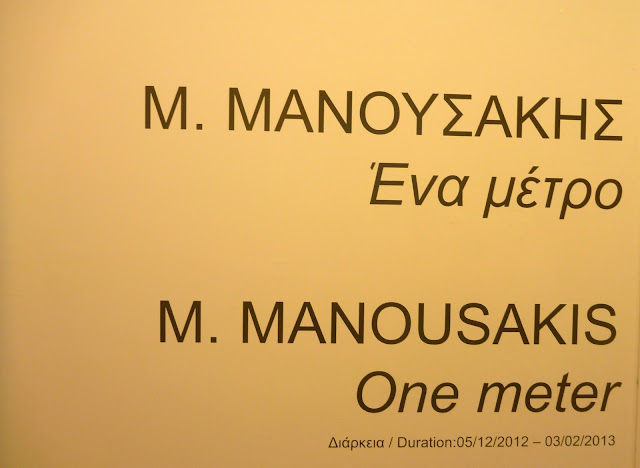We went to the Museum of Contemporary Art while we were in Athens but were very disappointed with all three exhibitions.
On our way out we spotted this and decided to have a look. An exhibition of items in Michalis Manousakis' personal collection. A reminder - a violent reminder - of Greece's not too distant past, and what that entailed.
This is a reader for the third year of primary school. Greek children in uniform giving the Nazi salute.
The year is 1939. Greece is under the dictatorship of Ioannis Metaxas, a dictatorship that was established in 1936 when he suspended Greek Parliament as well as articles of the Constitution. He modelled himself on fascist movements in Europe and particularly Mussollini's Italy, but unlike the Italian fascists, he lacked the support provided by a mass political party. He banned political parties, prohibited strikes and introduced media censorship.
This was followed by a campaign against what he saw as anti-Greek literature. Book burning targeted authors like Shaw, Freud, Goethe and several Greek writers. He became Minister of Education in 1938 and had all school texts re-written to fit the regime's ideology.
These little girls are the Eaglets (Balafas). Fully aware of what they were doing, despite their young age, these children delivered secret messages as part of the liberation struggle against the German occupiers.
When the Italian army tried to invade Greece, the Greek army proved to be a formidable opponent, forcing the Italians to retreat. In 1941 the Germans came to the aid of Italy and invaded Greece which suffered greatly during the German occupation, resulting in one of the greatest famines in the history of Europe. Between 1941 and 1946, inflation rose more than five trillion times. Oxfam in the U.K. was formed to help the starving in Greece.
As a result, Greek resistance, one of the most effective resistance movements in Occupied Europe, was formed. Resistance groups launched guerilla attacks against the occupiers and set up large espionage networks.
The Germans retaliated. Some of the worst atrocities committed by the Wehrmarcht in Europe were committed in Greece. The list is endless but here are a few examples:
- 80% of the Jewish community, mainly in Salonika, were killed after being packed into cattle trucks and shipped off to Poland
- in 1944 all of the inhabitants of Distomo were massacred. When the Red Cross visited the village they found bodies (some still breathing) nailed with bayonets to the trunks of the trees that lead to the village
- 500 males were executed in Kalavrita
- 317 inhabitants were executed in the village of Kommeno
- to stop attempts to sabotage railway lines, the klouves were introduced: people in open air wagons which were covered with barbed wire
- 120000 Greeks were made homeless by the end of the war
- five thousand schools were wrecked.
These comics are from the 50s. 'Little Hero' and shadow puppet figures, reminders of the atrocities of the war.

Greece's history is being played out again today. Black clad motorcyclists roam the streets at night looking for their next non-white victim to beat up or worse, to murder. What is particularly worrying is the invasion of the Neo-Nazi party in schools: hearts that encircle the nazi logo on pink school bags; kids wearing black with closely cropped heads; Nazi logos engraved on school desks; parents that demand two different prayers during morning assembly - one which is exclusively Christian for the 'Greek' kids; parents demanding a morning ritual of allegiance to the flag; parents arguing and fighting during parents' evenings as some parents object to fascist interventions.
A student was knifed in the playground in Palaio Faliro two weeks ago because he had made comments against the neo-Nazis. A teacher came into his classroom and found the swastika written on the blackboard: 'doing division seemed irrelevant at that stage', he explained, 'I abandoned maths and had a history lesson instead. At the next parents' evening I was accused of cramming propaganda down the students' throats'. A teacher who was organising celebrations for the commemoration of the Polytechnic uprising which subsequently led to the fall of the junta was warned against doing so by a student who informed her that if the celebrations went ahead, there would be trouble.
As a consequence of this, the last six months have seen a huge rise in the anti-racist/anti-fascist movement in Greece. There are over 400 organisations in cities, towns, even small villages, workplaces, educational institutions, all determined to stop the rise of this campaign of hatred.
During last year's obligatory parades on Greece's Independence day, huge numbers of students wore anti-fascist armbands to show their opposition to the rise of this group and its message of hatred.
The old divisions that tore the country apart during the civil war which followed the end of WWII are being re-enacted again. Learning the lessons history has taught us might sound like a cliche, but it is as true now as it ever was.
For further information about Greece and lots more on current affairs go to: http://99getsmart.com/









No comments:
Post a Comment